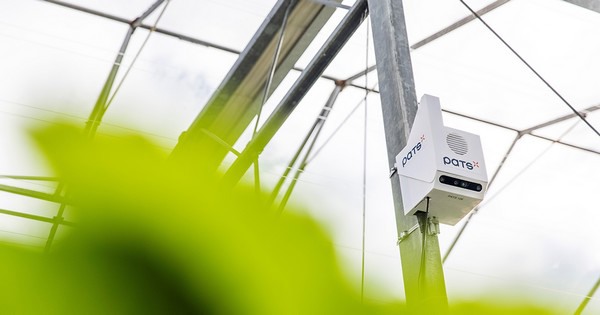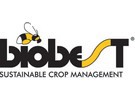While IPM systems in high-value strawberry crops are well established and widely adopted, Biobest adviser Arno Hellemons outlines the latest developments. New in the Biobest portfolio is a scouting system to help improve moth control and an expanding range of aphid controls, including a new generalist lacewing predator.
Automated scouting system accurately identifies moths
IPM in high-tech strawberry crops has taken a further step forward with the introduction of our new plug-and-play PATS-C scouting system, capable of detecting moth pests - including Duponchelia fovealis - 5-6 weeks earlier than pheromone traps leading to improvements in control.
“Available worldwide from Biobest, PATS-C can accurately detect nine moth species while also pinpointing the time of day each species is active,” says Arno. “With data comes knowledge which allows for an earlier and more accurate introduction of biological agents.”

“Duponchelia caterpillars feed on young shoots at the heart of strawberry plants, as well as the fruits. Until now, monitoring relying on visual detection using pheromone traps was the standard. PATS-C is a completely automatic system, requiring no staff and can often provide data before the pests are visually detected, saving the growers time in their scouting program.”
”One well-positioned PATS-C camera per hectare – which takes just 10-15 minutes to install – provides an invaluable early insight into the moths present in the glasshouse,” explains Arno. “This empowers growers to act earlier, optimizing the biological control program while saving labor and improving overall efficiency.”
Protac plays a role in whitefly control
Turning to whitefly control, he explains that Swirskii-System plays a dual role, as the predator feeds on thrips larvae as well as whitefly larvae and eggs. “A single product is helping to control two key pests. Growers also widely use our Encarsia-System cards using multiple introduction points. This parasite doesn’t tend to fly large distances, and strawberries being a dense crop, benefit from having plenty of introduction points.”
In addition, Arno strongly recommends spraying Biobest’s new physical-acting control agent Protac SF® on June bearers while making one or two early applications to the subsequent everbearer crop - ensuring a clean start.
“Protac SF provides good control of active stages of pests including whitefly and aphids and enables a quick introduction of beneficials after application and continuous harvest as it does not have a minimum residue limit,” he explains. “It’s useful when plants are still small and again, later in the season, to control pest hotspots.”
Aphid control bolstered with new options
He goes on to say that aphid control is complicated by the fact that while up to 15 different species can be found in strawberry crops, some parasitic controls are species-specific, so it is advisable to combine with generalist predators in the control program.
“As part of the preventative strategy, we recommend deploying several different parasitoids – we offer a range including Ervi-System, Aphidius-System, Matricariae-System, and Aphelinus-System,” says Arno.
“As the season progresses, our Aphi-Mix-System should be added to the strategy. Containing four aphid parasitoids, it provides good control of 95% of aphid species. We advise weekly introduction at a rate dependent on pest pressure. In everbearers, cropped throughout summer and early autumn, it can build up a good population.”
Turning to Biobest’s growing portfolio of lacewing products, Arno says: “our new robust brown lacewing Micromus-System is a generalist predator, with both the larvae and adults predating on all aphid species including Chaetosiphon - which currently doesn’t have a parasitoid. Micromus has a key role to play in control strategies for everbearers - where it has sufficient time to build numbers.”
As part of the early aphid preventative strategy, Arno also recommends employing Sphaerophoria-System (Sphaerophoria rueppelli) and Eupeodes-System (Eupeodes corollae) – two generalist predators which feed on all aphid species.
“At the first signs of aphids we recommend introducing Eupeodes, which prey on non-parasitized aphids and performs well in lower temperatures,” he explains. “Sphaerophoria-System can then be introduced when temperatures rise. These hoverflies can also feed on nectar, helping them establish early when the pest pressure is low, and can also act as pollinators.”
“Both these hoverflies scout well and can fly several kilometers in search of prey. Highly mobile, they make a great addition to Biobest’s preventative aphid strategy.”
Controlling thrips
Moving on to thrips control, strawberry growers routinely monitor this pest using Bug-Scan sticky traps or rolls for early detection before introducing one or more predators.
“The Swirskii-Breeding-System and Amblyseius-Breeding-System are widely used with additional loose A. cucumeris and A. swirskii material introduced as necessary,” explains Arno.
“If the pest pressure builds above a certain level, Orius-System is there to fall back on. Depending on the pest pressure, we recommend introducing 1 to 10 Orius/m2.”
“Thanks to our recently redesigned 100% biodegradable packaging including a food source, this predator now arrives on the nursery in even better shape - enhancing establishment as well as performance.”
For more information:  Biobest Group NV
Biobest Group NV
T: +32 14 25 79 80
info@biobestgroup.com
www.biobestgroup.com
